Organizing your Scene
Overview
The bigger your level becomes, the more objects there will be within it, which leads to a high chance of things getting cluttered and confused. The Layer system is an easy way to keep your objects organized in a friendly way.
The Grouping system is another way to control multiple objects as a single thing.
Linking allows you to create parent/child links between your objects, passing down changes through the hierarchy.
Table of Content
RollUp Bar Layers
Layer Settings
Layer creation icons
In the Rollup Bar, there is a layer tab, with a few useful buttons, and the layer list. Also, there will always be a “main” layer, by default.
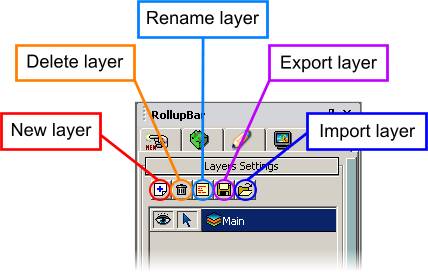
New Layer
This button will create a new layer. After clicking on it, a dialog will appear
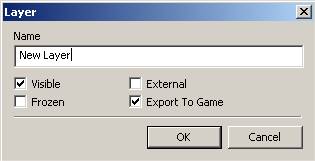
Be sure to enter a useful and recognizable name for your layer, possibly indicating what the function of what it contains, or a description of what it contains. For example “beach area” or “sounds”.
Delete Layer
This button will delete the currently selected layer. A dialog will appear and ask for confirmation. Once a layer is deleted, it cannot be restored without reloading a previous version of the level, or re-importing the layer if it is external.
Rename Layer
This button will open the dialog box which will allow you to rename the currently selected layer.
Export Layer
This button will open a browser window, allowing you to export your layer to a file. Make sure your layer file has the .lyr extension to it. This layer file can be imported into other levels, if required.
Import Layer
This button allows you to import a layer which has been exported previously, Locate your layer using the browser window.
Selecting layers
Left click on the name of a layer to select it
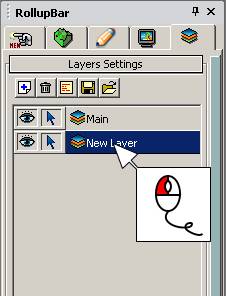
Assigning objects to layers
When you have more than one layer in your level, you can assign a specific layer to your objects. Select an object and look in the rollup bar. You will see the layer icon, shown below. Click it, and it will open the layer selection menu.
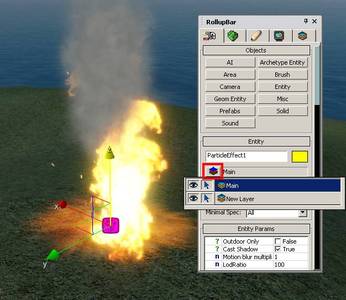
By default any object is placed in the layer “Main”, unless you have another selected from the layers menu.
Hide/show and freeze/unfreeze on layers
After assigning layers to your objects and entities, there are a few additional ways to manage them. Go to the layer list in the rollup bar.
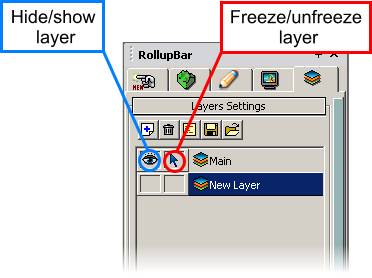
Toggling the eye icon will hide/show the objects in that layer.
Toggling the arrow icon will allow interaction with objects when the icon shows (objects are unfrozen), and disallow interaction when the icon is hidden (objects are frozen).
Double clicking on an icon will make all layers change their state of hide/show or frozen/unfrozen, depending on which icon was selected.
Layer Settings
To enter layer settings, select your layer then right click on the layer name.
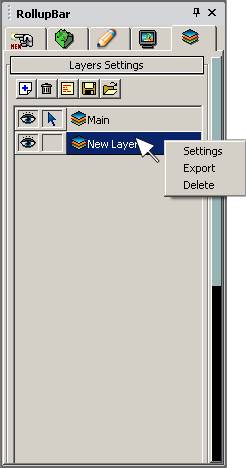
The following dialog box will appear

Visible
Does the same thing as the layer hide/show icon.
Frozen
Does the same thing as the layer freeze/unfreeze icon.
External
When this checkbox is enabled, the layer will automatically be exported when your level is saved, and imported on load. The layer will now function externally to the .cry file, and can be edited independently. Unchecking this box will make the layer part of the .cry file again, and the external .lyr file will no longer be updated.
Export to Game
When this checkbox is enabled, the layer will be exported to the game when you use
File/Export to engine . Uncheck this if you don’t wish to see the objects contained in the layer in pure game mode.
Grouping
Grouping objects is very useful for manipulating several objects as one single entity.
The grouping function
To create a group, you must first select the objects you want to be within the group – do this by dragging a selection box round them, or selecting them individually.
Group
One important thing to remember about groups – once an object is within a closed group, it cannot be edited independently, so make sure you set up your objects beforehand.
A group can be created by going up to the main menu bar and selecting Group from the Group menu
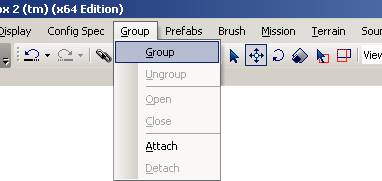
The following dialog will appear
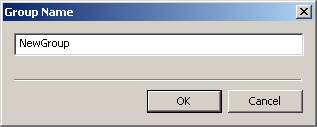
After successful grouping the objects, a wireframe box will appear around your group, with a group specific pivot point.
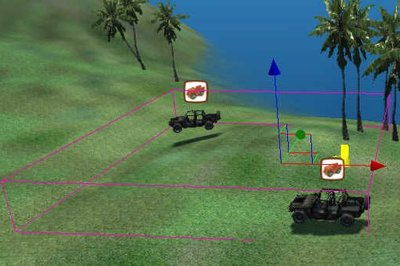
Ungroup
This will revert all objects in your group back to their individual state.
Open
This function allows to “open” up a group and edit each individual object within it, without ungrouping.
Close
This will “close” a group that was previously opened.
Attach
Select the desired object, click this option, then select the desired group, and the object will be added to it.
Detach
Removes the selected object from its group. To select an object within a group, first you must open the group.
Saving Grouped Objects
To save your group to an external file, go to the modify section of the toolbar and select “Save Object(s)…”. To load in a previously saved group, in the same menu, select “Load Object(s)…”
Linking
Linking an object to another will create a parent - child connection between two objects. Changes to the parent object are propagated to any child objects. This link works in one direction only – changing the child will not affect the parent.
This is also useful for linking 2 flowgraph animated objects to each other, to perform actions together.
Link
Link and unlink can be found in the modify menu…
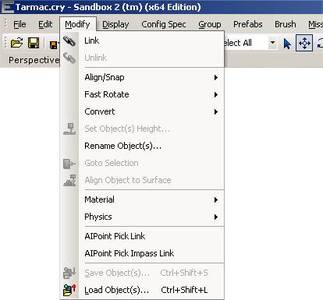
…or on the main icon bar. Left icon is link, right is to unlink 
To link two objects, click link, then click and hold your left mouse button down on the child object. Next move the mouse to the intended parent object and release the mouse button.
Unlink
By clicking unlink on the child object, all links and dependencies are removed.

Entity Linking
This has a completely separate functionality to the previously explained linking
You can create logical links via the entity properties browser in the RollupBar. This is used to logically associate two objects to each other – for example, connecting an area shape to an area trigger.
Select your Entity, scroll down to the area “Entity Links” in the RollupBar and click the button “Pick Target”, than click on the desired target.
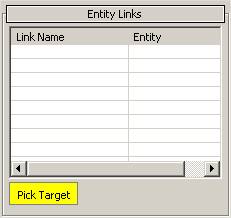
A green line will indicate your link.
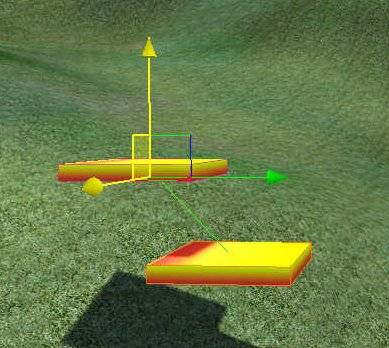
Right click on the link in the objects settings in the RollupBar to edit its properties.
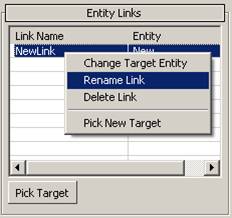
Change Target Entity
Click this and you will be able to select a new target for your link.
Rename Link (which is always to suggest)
This will allow you to give your link a new name.
Delete Link
This will remove the link permanently
Pick New Target
This will allow you to pick additional targets for your entity. Right clicking in an empty field in the “Entity Link” box will also bring up this option.
Linking during runtime via Flow Graph
Flow Graph will also allow you to link and unlink objects while the game is running.
The associated nodes are found in the Entity folder in Flow Graph. The two Nodes are “Attach Child” to attach an entity, and “Detach This” to detach an entity.
For more detailed information how to use Flow Graph and linking, please refer to the external Flowgraph documentation.













